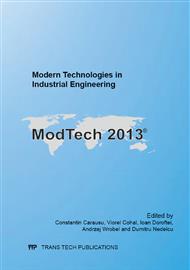p.603
p.607
p.612
p.618
p.624
p.628
p.634
p.639
p.645
Model and Analysis of the Key Factors Influencing Organizational Changes Implementation within Business Processes
Abstract:
Change is a common place nowadays. The fulminant engineering, innovation and globalization era brought with it an avalanche of changes and multiple challenges that organizations must face. Despite the change theme has been thought out and researched by hundreds of specialists, the practice shows that organizations have yet difficulties in implementing the changes they need. This is the motive why managers must deal with the issue of organizational changes carefully and take into consideration all factors that contribute to successful implementation of projects and changes that may increase the performance of companies they belong. Purpose The aim of this article is modelling and analysis the key factors that influence the organizational changes implementation within the business processes. Research, methodology Based on the main concepts in literature, a new specific model centered on the key factors that influence the organizational changes implementation within business processes will be presented and analysed. Findings The results indicate the main factors that influence change implementation in business processes and show a number of solutions for increase the success rate of this challenge for all the leaders of organizations. Originality, value The article promote a specific model of key factors that influence the organizational changes implementation, based on a critical review of change management literature. Numerous authors suggest a lot of recommendations for using and combining the factors of changes implementation, so that the results of change efforts to be the expected ones, but it is up to the leaders how they manage to implement researchers solutions in their organizations. This article presents that specific ways for Romanian managers, fitting with Romanian business environment. Implications This work leads to a better understanding of the key factors of the organizational changes implementation. The managers will have new perspectives to approach this matter and new solutions, in order to improve the change processes required by business.
Info:
Periodical:
Pages:
624-627
Citation:
Online since:
November 2013
Authors:
Price:
Сopyright:
© 2014 Trans Tech Publications Ltd. All Rights Reserved
Share:
Citation:


